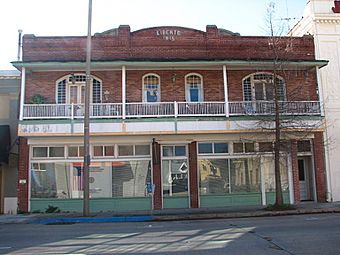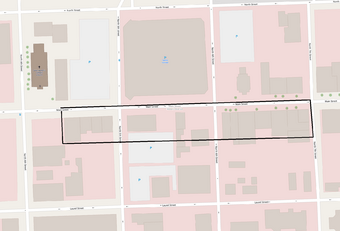Main Street Historic District (Baton Rouge, Louisiana) facts for kids
Quick facts for kids |
|
|
Main Street Historic District
|
|

Liberto Building at 624-626 Main Street
|
|
 |
|
| Location | Main Street between North 4th Street and North 7th Street, Baton Rouge, Louisiana |
|---|---|
| Area | 2.5 acres (1.0 ha) |
| Architectural style | Classical Revival, Late Victorian, Art Deco |
| NRHP reference No. | 85002785 |
| Added to NRHP | November 7, 1985 |
The Main Street Historic District is a special part of downtown Baton Rouge, Louisiana. It's found along Main Street, stretching from North 4th Street to North 7th Street. This area is like a time capsule, showing how the city looked long ago.
It's called a historic district because it has many old buildings that are important to history. This district covers about 2.5 acres (1 hectare) and includes 11 old commercial buildings. These buildings were built between the late 1800s and the mid-1930s.
On November 7, 1985, this historic district was officially added to the National Register of Historic Places. This means it's recognized nationally for its historical value.
Contents
Discovering Main Street's Past
Imagine walking down Main Street and seeing buildings that are over 100 years old! The Main Street Historic District helps us remember what life was like in Baton Rouge a long time ago. It's a great place to learn about the city's past.
What Makes a Place Historic?
A "historic district" is an area with a group of buildings, structures, or objects that are important because of their history, architecture, or culture. These places help us understand how people lived and worked in the past. The buildings in this district show different styles popular during their time.
Architectural Styles You Can Spot
The buildings in the Main Street Historic District feature interesting architectural styles:
- Classical Revival: This style uses ideas from ancient Greek and Roman buildings, like columns and grand entrances.
- Late Victorian: These buildings often have lots of decoration, different textures, and sometimes towers or turrets.
- Art Deco: Popular in the 1920s and 1930s, this style uses geometric shapes, sleek lines, and often colorful designs.
Buildings That Tell a Story
The district has 11 "contributing properties." This means these buildings are important because they add to the historical character of the area. They were all built between around 1890 and 1935.
Here are some of the notable buildings in the district:
- Saltz Building: Built in 1924, this building at 442 Main Street is a good example of the architecture from that time.
- Liberto Building: Located at 624-626 Main Street, this building was constructed in 1915. It's one of the well-known structures in the district.
- Duggan Building: Found at 618 Main Street, this building dates back to around 1920.
These buildings, along with others like the one at 500 Main Street (built around 1890) and 660 Main Street (built around 1920), help us see how Baton Rouge grew and changed over the years. They are like living museums that show us the city's rich history.

